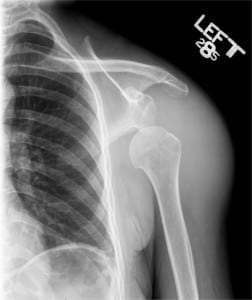| Author | Affiliation |
|---|---|
| Jacob Manteuffel, MD | Henry Ford Hospital, Department of Emergency Medicine, Detroit, MI |
A 42-year-old female with a past medical history significant for intravenous drug abuse presented to the emergency department complaining of a two-week history of worsening left shoulder pain. She denied any trauma to the shoulder but noted it had become increasingly difficult to move secondary to pain. On physical exam she was afebrile and the rest of her vital signs were within normal limits. Asymmetry was noted between the right and left shoulders and the left shoulder was warm, erythematous and tender to palpation. Her left arm was held in adduction and internal rotation, with extremely limited range of motion secondary to pain. We obtained a radiograph of the shoulder and laboratory tests that revealed an elevated white blood cell count of 12.9, erythrocyte sedimentation rate of 66 mm/hr and a C-reactive protein level of 5.4 mg/dl. Orthopedic surgery was then consulted. A needle tap of the left shoulder yielded 30 ml of purulent fluid. Lab cultures grew methicillin-resistant Staphylococcus aureus, and the patient was started on empiric intravenous vancomycin. In the operating room orthopedic surgery found that the patient had an extracapsular subdeltoid abscess.
A review of the literature indicates this is a rare case of an extracapsular abscess causing marked radiographic evidence of dislocation in the shoulder. There are case reports of septic arthritis in the shoulder represented with radiographic evidence of dislocation.1 Atlanto-axial subluxation secondary to retropharyngeal abscess is described; however, there are no reports of similar dislocations outside of the axial skeleton.2 This case reinforces the point that every dislocation is not secondary to trauma. It also emphasizes the importance of a detailed history and physical examination to discern the causes of pain, with corroboration of radiographic findings.

Footnotes
Supervising Section Editor: Sean Henderson, MD
Submission history: Submitted March 20, 2009; Accepted April 6, 2009
Full text available through open access at http://escholarship.org/uc/uciem_westjem
Address for Correspondence: Jacob Manteuffel, MD, Department of Emergency Medicine, Henry Ford Hospital, 2799 W. Grand Blvd, Detroit, MI 48201
Email jmanteu1@hfhs.org
Conflicts of Interest: By the WestJEM article submission agreement, all authors are required to disclose all affiliations, funding sources, and financial or management relationships that could be perceived as potential sources of bias. The authors disclosed none.
REFERENCES
1. Gomplels BM, Darlington LG. Septic arthritis in rheumatoid disease causing bilateral shoulder dislocation: diagnosis and treatment assisted by grey scale ultrasonagraphy. Ann Rheum Dis.1981;40:609–11. [PMC free article] [PubMed]
2. Welinder NP, Hoffmann P, Hakansson S. Pathogenesis of non-traumatic atlanto-axial subluxation (Grisel’s syndrome) Eur Arch Otorhinolaryngol. 1997;254:251–4. [PubMed]


